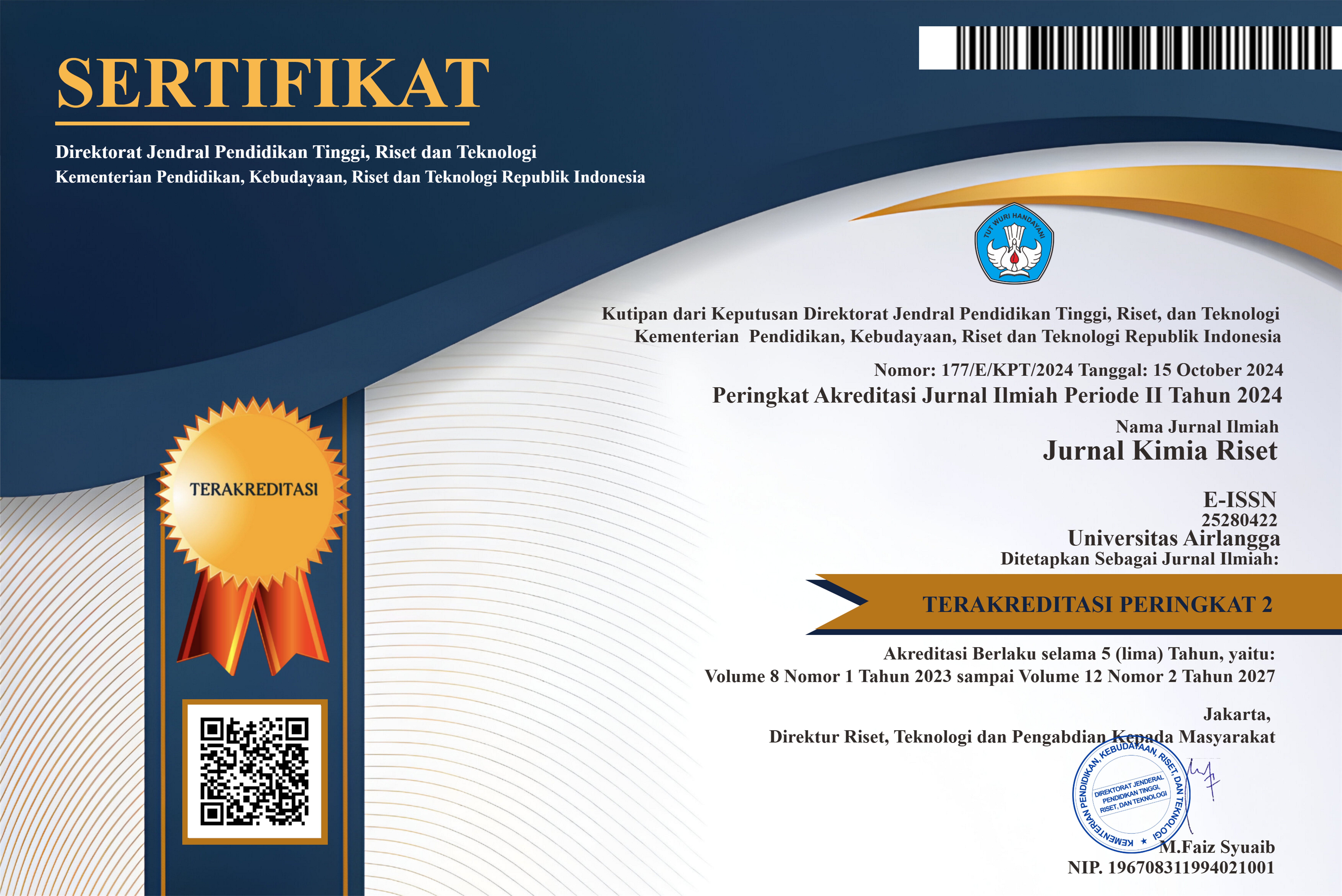Phytochemical Screening of Bioactive Compounds and Antioxidant Activity of Different Extracts From the Fruits and Barks of Ficus racemosa
Downloads
Ficus racemosa, also known as the fig plant, is renowned for its diverse medicinal properties. In light of this, our research aims to study the phytochemical compounds present in several extracts of fruits and barks of Ficus racemosa, as well as the antioxidant activity explored in the gradual solvent polarities (methanol, ethyl acetate, and hexane). The dried fruit and bark of Ficus racemosa were utilized, and extraction was obtained through successive extraction at room temperature following the cold maceration technique. Preliminary phytochemical screening of fruit and bark extracts revealed the presence of alkaloids, flavonoids, and tannins. The extracts were subjected to antioxidant activities by the 2,2-diphenyl-1-picryl-hydrazyl (DPPH) assay. Antioxidant capacity revealed the IC50 value of the methanol and ethyl acetate fruit extract of Ficus racemosa, which offered a strong capacity of 67.114 μg/mL and 69.149 μg/mL. These results indicate that the crude extract from Ficus racemosa fruit could serve as a candidate for a natural antioxidant against free radicals.
Ahmed, F., Hudeda, S., & Urooj, A. (2011). Antihyperglycemic activity of Ficus racemosa bark extract in type 2 diabetic individuals. In Journal of Diabetes (Vol. 3, Issue 4, pp. 318–319). https://doi.org/10.1111/j.1753-0407.2011.00152.x
Alharbi, H. O. A., Alshebremi, M., Babiker, A. Y., & Rahmani, A. H. (2025). The Role of Quercetin, a Flavonoid in the Management of Pathogenesis Through Regulation of Oxidative Stress, Inflammation, and Biological Activities. In Biomolecules (Vol. 15, Issue 1). Multidisciplinary Digital Publishing Institute (MDPI). https://doi.org/10.3390/biom15010151
Azwanida, N. (2015). A Review on the Extraction Methods Use in Medicinal Plants, Principle, Strength and Limitation. Medicinal & Aromatic Plants, 04(03). https://doi.org/10.4172/2167-0412.1000196
Bae, H., Jayaprakasha, G. K., Crosby, K., Jifon, J. L., & Patil, B. S. (2012). Influence of Extraction Solvents on Antioxidant Activity and the Content of Bioactive Compounds in Non-pungent Peppers. Plant Foods for Human Nutrition, 67(2), 120–128. https://doi.org/10.1007/s11130-012-0290-4
Bheemachari, J., Ashok, K., Joshi, N. H., Suresh, D. K., & Gupta, V. R. M. (2007). Antidiarrhoeal Evaluation of Ficus racemosa LINN., Latex. Acta Pharmaceutica Sciencia, 49, 133.
Bopage, N. S., Kamal Bandara Gunaherath, G. M., Jayawardena, K. H., Wijeyaratne, S. C., Abeysekera, A. M., & Somaratne, S. (2018). Dual function of active constituents from bark of Ficus racemosa L in wound healing. BMC Complementary and Alternative Medicine, 18(1). https://doi.org/10.1186/s12906-018-2089-9
Chaware, G. K., Kumar, V., Kumar, S., & Kumar, P. (2020). Bioactive Compounds, Pharmacological Activity and Food Application of Ficus racemosa: A Critical Review. In International Journal of Fruit Science (Vol. 20, Issue S2, pp. S969–S986). Bellwether Publishing, Ltd. https://doi.org/10.1080/15538362.2020.1774467
Chen, W. C., Wang, S. W., Li, C. W., Lin, H. R., Yang, C. S., Chu, Y. C., Lee, T. H., & Chen, J. J. (2022). Comparison of Various Solvent Extracts and Major Bioactive Components from Portulaca oleracea for Antioxidant, Anti-Tyrosinase, and Anti-α-Glucosidase Activities. Antioxidants, 11(2). https://doi.org/10.3390/antiox11020398
Elsherif, K. M., Ewlad-Ahmed, A. M. M., Alhlbad, E. A. A., & Iqneebir, A. M. (2023). Phytochemical Screening, Antioxidant Capacity Measurement, and Mineral Content Determination of Thymus vulgaris L. Extracts. Walisongo Journal of Chemistry, 6(2), 168–180. https://doi.org/10.21580/wjc.v6i2.17818
Flieger, J., Flieger, W., Baj, J., & Maciejewski, R. (2021). Antioxidants: Classification, natural sources, activity/capacity measurements, and usefulness for the synthesis of nanoparticles. Materials, 14(15). https://doi.org/10.3390/ma14154135
Gardia, D., Mishra, A. K., Priyadarsini, S., Tanty, R., Parua, B., & Khamari, A. (2021). Effects of herbal ointment prepared from ethanolic extract of Ficus racemosa leaves on wound causing bacteria. International Journal of Pharmacognosy and Pharmaceutical Sciences, 3(2), 44–46. https://doi.org/10.33545/27067009.2021.v3.i2a.96
Hasana, N., Yani, D. F., & Wijayanti, F. (2024). Activity Test of Methanol Extract of Young Stem Bark of Semambu rattan Plant (Calamus Scipionum Lour) with DPPH Method. Walisongo Journal of Chemistry, 7(1), 8–15. https://doi.org/10.21580/wjc.v7i1.17350
Hidayanti, B. R., Suryani, N., & Dewi, Y. K. (2023). Phytochemical Screening and Antioxidant Activity Test of Ara Fruit Extract (Ficus racemosa Linn.) using DPPH Method. SPIN-Jurnal Kimia & Pendidikan Kimia, 5(2), 177–191. https://doi.org/10.20414/spin.v5i2.7306
Hosoya, T., Masuda, Y., Ohba, S., & Kumazawa, S. (2024). Component analysis of Cucumis melo L. leaves and their antioxidant activity. Natural Product Research. https://doi.org/10.1080/14786419.2024.2416508
Ismail, N. Z., Arsad, H., Samian, M. R., & Hamdan, M. R. (2017). Determination of phenolic and flavonoid contents, antioxidant activities and GC-MS analysis of Clinacanthus nutans (Acanthaceae) in different locations. Agrivita, 39(3), 335–344. https://doi.org/10.17503/agrivita.v39i3.1076
Itam, A., Wati, M. S., Agustin, V., Sabri, N., Jumanah, R. A., & Efdi, M. (2021). Comparative Study of Phytochemical, Antioxidant, and Cytotoxic Activities and Phenolic Content of Syzygium aqueum (Burm. f. Alston f.) Extracts Growing in West Sumatera Indonesia. Scientific World Journal, 2021. https://doi.org/10.1155/2021/5537597
Jabeen, S., Ali, M. F., Mohi ud Din, A., Javed, T., Mohammed, N. S., Chaudhari, S. K., Javed, M. A., Ali, B., Zhang, L., & Rahimi, M. (2023). Phytochemical screening and allelopathic potential of phytoextracts of three invasive grass species. Scientific Reports, 13(1). https://doi.org/10.1038/s41598-023-35253-x
Katkar, R. M., Makone, S. S., Kedar, T., & Ahmed, N. T. B. (2024). Formulation and Evaluation of Herbal Gel of Ficus racemosa for WOund Healing Activity. Journal of Chemical Health Risks, 1(14), 1661–1669.
Krüzselyi, D., Ott, P. G., & Móricz, Á. M. (2023). Exploring antioxidant potential in two basidiomycetous mushrooms using high-performance thin-layer chromatography–DPPH–videodensitometry. Journal of Planar Chromatography - Modern TLC, 36(6), 503–511. https://doi.org/10.1007/s00764-023-00271-y
Kumar Dubey, P., Yaduwanshi, P., & Gouttam, V. (2018). Ficus racemosa Lin-Gooler a Review. World Journal of Pharmaceutical Research, 7, 325. https://doi.org/10.20959/wjpr201812-12653
Kusuma Dewi, Y., & Suryani, N. (2024). Physico-chemical characteristics of Figs Herbal Tea (Ficus racemosa L.) as a functional antidiabetic drink. Journal of Natural Sciences and Mathematics Research J. Nat. Scien. & Math. Res, 10(2), 178–188. http://journal.walisongo.ac.id/index.php/jnsmr
Liu, G., Zhou, L., Mu, K., Peng, L., Ran, F., Feng, G., & Liu, Y. (2024). Based on Spectrum-Effect Relationship, Network Pharmacology, and Molecular Docking, the Material Basis and Mechanism of Antioxidant Effect of Miao Medicine Indigofera stachyoides Lindl Were Studied. ACS Omega. https://doi.org/10.1021/acsomega.4c04212
Lv, H., & Guo, S. (2023). Comparative analysis of flavonoid metabolites from different parts of Hemerocallis citrina. BMC Plant Biology, 23(1). https://doi.org/10.1186/s12870-023-04510-6
Mohan B. N., P., Jayaram, S., & Kuriachan, S. (2021). Study of anti-inflammatory activity of Ficus racemosa linn stem bark extracy in albino rats. International Journal of Basic & Clinical Pharmacology, 10(3).
Mustarichie, R., Runadi, D., & Ramdhani, D. (2017). The antioxidant activity and phytochemical screening of ethanol extract, fractions of water, ethyl acetate, and n-hexane from mistletoe tea (Scurrula atropurpurea BL. dans). Asian Journal of Pharmaceutical and Clinical Research, 10(2), 343–347. https://doi.org/10.22159/ajpcr.2016.v10i2.15724
Okselni, T., Tasfiyati, A. N., Juliadmi, D., Handayani, U. F., Saputri, A., Dewi, R. T., & Septama, A. W. (2024). An extraction technique to reach the effective radical scavenging constituents from the leaves of Indonesian malva nut tree (Scaphium macropodum): A comparative study of maceration, heat-assisted, ultrasound-assisted, and microwave-assisted extraction. Biocatalysis and Agricultural Biotechnology, 55. https://doi.org/10.1016/j.bcab.2023.102999
Olszowy-Tomczyk, M. (2021). How to express the antioxidant properties of substances properly? In Chemical Papers (Vol. 75, Issue 12, pp. 6157–6167). Springer Science and Business Media Deutschland GmbH. https://doi.org/10.1007/s11696-021-01799-1
Peiris, D. S. H. S., Fernando, D. T. K., Senadeera, S. P. N. N., & Ranaweera, C. B. (2023). View of Phytochemical Screening for Medicinal Plants: Guide for Extraction Methods. Asian Plant Research Journal, 4, 13–34.
Prajapati, P., Maitreya, B. B., & Rawal, R. M. (2024). Qualitative and quantitative phytochemical screening and chemical fingerprint analysis of Conocarpus lancifolius plant using HPTLC. Vegetos. https://doi.org/10.1007/s42535-024-00892-6
Rao, A., Kumari, S., Laura, J. S., & Dhania, G. (2023). Qualitative Phytochemical Screening of Medicinal Plants Using Different Solvent Extracts. Oriental Journal Of Chemistry, 39(3), 621–626. https://doi.org/10.13005/ojc/390312
Ravichandiran, V., Nirmala, S., & Nazeer Ahamed, K. (2012). Protective effect of tannins from Ficus racemosa in hypercholesterolemia and diabetes induced vascular tissue damage in rats Asian Pacific Journal of Tropical Medicine. In Asian Pacific Journal of Tropical Medicine. www.elsevier.com/locate/apjtm
Shi, Y., Mon, A. M., Fu, Y., Zhang, Y., Wang, C., Yang, X., & Wang, Y. (2018). The genus Ficus (Moraceae) used in diet: Its plant diversity, distribution, traditional uses and ethnopharmacological importance. In Journal of Ethnopharmacology (Vol. 226, pp. 185–196). Elsevier Ireland Ltd. https://doi.org/10.1016/j.jep.2018.07.027
Shi, Y. S., Yang, L., Yu, M. F., Li, Z. H., Ke, Z. J., Qian, X. H., Ruan, X., He, L. P., Wei, F., Zhao, Y. X., & Wang, Q. (2022). Seasonal variation influences flavonoid biosynthesis path and content, and antioxidant activity of metabolites in Tetrastigma hemsleyanum Diels & Gilg. PLoS ONE, 17(4 April). https://doi.org/10.1371/journal.pone.0265954
Sivakumar, P., Manimekalai, I., Sivakumari, K., & Ashok, K. (2019). Anticancer Effect of Fig Fruit Ficus racemosa Extract Against Human Heptocellar Carcinoma (HepG-2) Cell Line. IJRAR, 6(1), 767–783. www.ijrar.org
Srinivasan, B., & Lloyd, M. D. (2024). Dose-Response Curves and the Determination of IC50 and EC50 Values. In Journal of Medicinal Chemistry. American Chemical Society. https://doi.org/10.1021/acs.jmedchem.4c02052
Suryani, N., & Gustiana, S. (2023). Toxicity Test of Elo (Ficus Racemosa L.) Leaf Extracts and Fractions Using Brine Shrimp Lethality Test Methods. Al-Kimia, 11(2). https://doi.org/10.24252/al-kimia.v11i2.40821
Tamuly, C., Buragohain, R., Hazarika, M., Bora, J., & Gajurel, P. R. (2015). Assessment of Antioxidant Activity of Six Ficus Species—Underutilized Fruits from Arunachal Pradesh in North East India. International Journal of Fruit Science, 15(1), 85–99. https://doi.org/10.1080/15538362.2014.931174
Tikent, A., Bouaouda, K., Laaraj, S., Chebaibi, M., Choubbane, H., Loukili, E. H., Elfazazi, K., Bouhrim, M., Mothana, R. A., Noman, O. M., Eto, B., Elamrani, A., & Addi, M. (2025). Nutritional value antioxidant strength and antimicrobial efficacy of fig pastes from eastern morocco. Scientific Reports, 15(1), 11693. https://doi.org/10.1038/s41598-025-93173-4
Veerapur, V. P., Thippeswamy, B. S., Prabhakar, K. R., Nagakannan, P., Shivasharan, B. D., Bansal, P., Sneha, S. D., Mishra, B., Priyadarsini, K. I., & Unnikrishnan, M. K. (2011). Antioxidant and renoprotective activities of Ficus racemosa Linn. stem bark: Bioactivity guided fractionation study. Biomedicine and Preventive Nutrition, 1(4), 273–281. https://doi.org/10.1016/j.bionut.2011.06.002
Wu, J., Xiao, Y., & Wang, C. (2025). Extraction, compositional analysis, in vitro antioxidant and antiproliferative activities of dandelion (Taraxacum officinale) seed oil. Food Chemistry, 476. https://doi.org/10.1016/j.foodchem.2025.143435
Xiang, Y., Hou, W., Wang, M., Feng, J., Li, W., & Liu, Y. (2025). Secondary metabolites and antioxidant activity of different parts from the medicinal and edible Alpiniae oxyphylla Miq. Journal of Functional Foods, 128. https://doi.org/10.1016/j.jff.2025.106803
Copyright (c) 2025 Jurnal Kimia Riset

This work is licensed under a Creative Commons Attribution-NonCommercial-ShareAlike 4.0 International License.
COPYRIGHT NOTICE
1. By submitting the article to Jurnal Kimia Riset (JKR), the author has agreed to transfer some of the copyrights to the publisher of the research chemistry journal, Universitas Airlangga, indicated in the Copyright Transfer Agreement.
2. Authors still retain significant rights to use and share their own published articles for non-commercial purposes subject to Creative Commons Attribution-NonComercial 4.0 International License
3. All publications (printed/electronic) are open access for educational purposes, research, library, and other non-commercial purposes. Besides the purposes mentioned above, the editorial board is not responsible for copyright violations.















